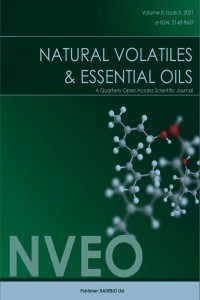Abstract
References
- Asakawa, Y. and Ludwiczuk, A. (2017). Chemical Constituents of Bryophytes: Structures and Biological Activity. Journal of Natural Products, 81(3):641-660.
- Chen, F., Ludwiczuk, A., Wei, G., Chen, X., C. Stotler, B., Bowman, J. L. (2018). Terpenoid secondary metabolites in bryophytes: chemical diversity, biosynthesis and biological functions. Critical Reviews in Plant Sciences, 37(2-3):210-231.
Antimicrobial and antioxidant activities and volatile constituents of Eurhynchium angustirete (Broth.) T. J. Kop. and Isothecium alopecuroides (Lam. ex Dubois) Isov. from Turkey
Abstract
The aim of the present study was to determine the chemical analysis, antimicrobial and antioxidant effects of the Eurhynchium angustirete (Broth.) and Isothecium alopecuroides (Lam. Ex Dubois) essential oil obtained by distillation method (Clevenger apparatus hydrodistillation). Obtained volatile oils were identified by gas chromatography-mass spectrometry (GC/MS) which revealed the presence of twenty-two components analyzed in the essential oil of E. angustirete representing 95.7% of the total identified compounds and twenty compounds were determined in the essential oil of I. alopecuroides representing 94.3% of the total identified compounds. Trans-pinocarveol and myrtenal as major constituents were 23.0% and 14.1% in E. angustirete and the main components were: biformene (9.9%), α-pinene (9.1%), bornyl acetate (8.4%) in I. alopecuroides. The essential oils from E. angustirete and I. alopecuroides showed higher metal-ion chelating activities which were 65.93±0.39% and 31.01±2.75, respectively. There was no significant difference results DPPH activity of essential oils 16.8±6.98 and 22.8%±8.91, respectively. The antimicrobial activity was investigated by microdiution method. The isolated essential oils were showed effective antimicrobial activities against Escherichia coli ATCC25922, Enterococcus faecalis ATCC29212, Staphylococcus aureus ATCC25923, Pseudomonas aeruginosa ATCC2785 and Streptococcus mutans. Antimicrobial effect values were found ranging of 90.76-95.38%. According to antimicrobial effect value against to microorganism, essential oil of E. angustirete was higher than I. alopecuroides.
Thanks
The author thanks to Amasya University Research Laboratory for antimicrobial and antioxidant activity.
References
- Asakawa, Y. and Ludwiczuk, A. (2017). Chemical Constituents of Bryophytes: Structures and Biological Activity. Journal of Natural Products, 81(3):641-660.
- Chen, F., Ludwiczuk, A., Wei, G., Chen, X., C. Stotler, B., Bowman, J. L. (2018). Terpenoid secondary metabolites in bryophytes: chemical diversity, biosynthesis and biological functions. Critical Reviews in Plant Sciences, 37(2-3):210-231.
Details
| Primary Language | English |
|---|---|
| Subjects | Engineering |
| Journal Section | Articles |
| Authors | |
| Publication Date | September 30, 2021 |
| Published in Issue | Year 2021 Volume: 8 Issue: 3 |

